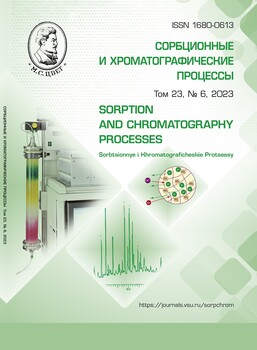Optimization of the thin layer chromatography method conditions for the detection of related dioxidine impurities
Abstract
When developing methods for analysing active pharmaceutical substances (API), it is necessary to take into account modern requirements for the content of impurities in them. At the same time, for some drugs that have been on the pharmaceutical market for a long time, analysis methods are still used that are unable to provide the necessary sensitivity and specificity. One of these API is 2,3-bis(hydroxymethyl)quinoxaline-1,4-dioxide (dioxidin), which has high bactericidal activity against a wide range of microorganisms. According to the requirements of the State Pharmacopoeia of the Russian Federation XIV edition, related impurities of this API are analysed by thin layer chromatography (TLC). However, this method is semi-quantitative and relative. The purpose of this work is to determination of impurities in the dioxydine substance using high-performance liquid and thin-layer chromatography methods. In accordance with the requirements of the monograph of the State Pharmacopoeia of the Russian Federation, the total content of all impurities in the API is assessed and only the content of quinoxidine is determined separately, which is often absent from the substance. For the first time, three typical dioxidine related impurities were revealed using HPLC. Next, we selected the optimal conditions for their detection by TLC. Methanol/acetonitrile (75/25) and dichloromethane/acetonitrile (50/50) mixtures were the most suitable as a solvent for impurities and the TLC elution system, respectively. Under the selected conditions, satisfactory separation of the chromatographic zones of all four impurities and the dioxidine substance was observed. The corresponding zones were clearly visible at a substance concentration of 1%. However, reducing their concentration to the required 0.1% made it difficult to visually detect impurities. Thus, even when optimizing TLC conditions, it is impossible to obtain reliable data on the content of related impurities, which is due to the limitations of the method. On the contrary, the analysis of dioxidine substances by HPLC allows fairly accurate quantitative determination of individual related impurities.
Downloads
References
Szajek A.Y., Chess E., Johansen K., Gratzl G., Gray E., Keire D., Al-Hakim A. The US regulatory and pharmacopeia re-sponse to the global heparin contamination crisis. Nat. biotechnol. 2016; 34(6): 625-630. https://doi.org/10.1038/nbt.3606
Volpi N., Maccari F., Suwan J., Linhardt R.J. Electrophoresis for the analy-sis of heparin purity and quality. Electro-phoresis. 2012; 33(11): 1531-1537. https://doi.org/10.1002/elps.201100479
Wahl O., Holzgrabe U. Amino acid analysis for pharmacopoeial purposes. Ta-lanta. 2016; 154: 150-163. https://doi.org/10.1016/j.talanta.2016.03.071
Kamb M.L., Murphy J.J., Jones J.L., Caston J.C., Nederlof K., Horney L.F., Swygert L.A., Falk H., Kilbourne E.M. Eosinophilia-myalgiasyndromein l-tryptophan-exposedpatients. Jama. 1992; 267: 77-82.
Hyun M.H., Jeong E.D., Shin M.S., Jin J.S. A comparison of analytical meth-ods for the content and purity of cefradine. Bull. Korean Chem. Soc. 2008; 29(6): 1185-1189. https://doi.org/10.5012/bkcs.2008.29.6.1185
Hendrix C., Roets E., Bervoets V.R., Thomas J., Pijcke M., Busson R., Hoogmartens J. Synthesis of potential im-purities of cefalexin and cefradine. Archiv der pharma. 1994; 327(4): 215-219. https://doi.org/10.1002/ardp.19943270405
Crombez E., Bens G.A., Van der Weken G., Van den Bossche W., De Moer-loose P. Application of thin layer and high performance liquid chromatography to the separation and determination of cephalexin in cephradine, in bulk powder and in phar-maceuticals. Chromatographia. 1978; 11(11): 653-657. https://doi.org/10.1007/BF02269000
Yongxin Z., Hendrix C., Busson R., Janssen G., Roets E., Hoogmartens J. Isola-tion and structural elucidation of an impu-rity of cefradine. J. Pharm. Biomed. Anal. 1994; 12(9): 1137-1140. https://doi.org/10.1016/0731-7085(94)00042-5
Hendrix C., Yongxin Z., Pijcke M., Roets E., Hoogmartens J. A comparative study of LC methods for analysis of cefradine. J. Pharm. Biomed. Anal. 1993; 11(7); 595-599. https://doi.org/10.1016/0731-7085 (93)80010-X
Beckett A.H., Ali H.M. Artifacts produced by using dichloromethane in the extraction and storage of some antihista-minic drugs. J. Chromatogr. A. 1979; 177(2): 255-262. https://doi.org/10.1016/S0021-9673 (01)96321-6
Li M., Ahuja E.S., Watkins D.M. LC-MS and NMR determination of a di-chloromethane artifact adduct, cyprohepta-dine chloromethochloride. J. Pharm. Bio-med. Anal. 2003; 31(1): 29-38. https://doi.org/10.1016/S0731-7085 (02)00599-X
Zhu S., Jiang J., Liu Y., Zou W., Hu P., Lu Y., Structural identification of the related substances of lorazepam tablets by LC-MS. J. China Pharm. Univ. 2021: 555-565.
Jatoi W.B., Shar G.Q., Makheja P.M. Scope of harmonization of pharmaco-poeial liquid chromatography (LC) meth-ods for diazepam and its related substances. Pak. J. Anal. Environ. Chem. 2015; 16(1): 6-9.
Bonfilio R., De Araujo M.B., Sal-gado H. R. N. Recent applications of ana-lytical techniques for quantitative pharma-ceutical analysis: a review. WSEAS Trans. Biol. Biomed. 2010; 7(4): 316-338.
Leistner A., Holzgrabe U. Impurity profiling of dapsone using gradient HPLC method. J. Pharm. Biomed. Anal. 2021; 198: 113982. https://doi.org/10.1016/j.jpba.2021.113982
Stefanowicz Z., Stefanowicz J., Mu-las K. Determination of tropicamide and its major impurity in raw material by the HPLC-DAD analysis and identification of this impurity using the off-line HPLC–FT-IR coupling. J. Pharm. Biomed. Anal. 2009; 49(2): 214-220. https://doi.org/10.1016/j.jpba.2008.10.024
Golubitckiy G.B., Kulikov A.L. Khromatograficheskie svojstva Arbidola i kolichestvennoe opredelenie ego primesej metodom obrashchenno-fazovoj vysokojef-fektivnoj zhidkostnoj khromatografii, Sorbtsionnye i khromatograficheskie protsessy, 2019; 12(6): 981-988. (In Russ.)
Temenchuk K.P., Dvoryantsyeva G.G., Musatova I.S., Elina A.S. Photo-chemical reactions of 2, 3-bis (hydroxyme-thyl) quinoxaline 1, 4-di-N-oxide (di-oksidin). Pharm. Chem. J. 1984. Vol. 18(12), pp. 848-853. https://doi.org/10.1007/BF00768342.
Budanova L.I., Vigdorchik M.M., Elina A.S., Kuzovkin V.A., Musatova I.S., Padeiskaya E.N., Sokolov S.D. Investiga-tion of the metabolism of dioxidin. Pharm. Chem. J. 1980; 14(1): 4-9.
Morgunina L.V., Volodina T.V. Pa-tent RF, № 2 517 761 C1, 2014.
Temenchuk K.P., Dvoryantseva G.G., Musatova I.S., Elina A.S. Investiga-tion of the kinetics of the redox reactions of dioxidine. Pharm. Chem. J. 1984; 18(5): 340-345. https://doi.org/10.1007/BF00766670







